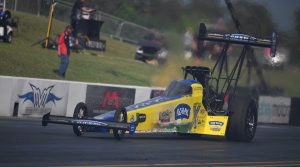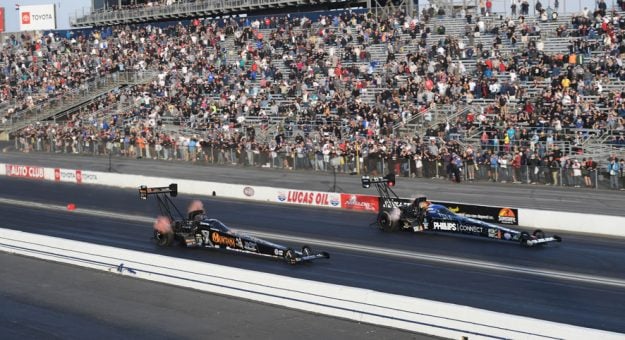On Nov. 1, In-N-Out Burger has became the title sponsor of the equally iconic Pomona, Calif., drag strip and the NHRA Finals.
The move took a bite out of the rumor that the 70-year-old race track would go the way of Atlanta Dragway, Houston Raceway Park, Virginia Motorsports Park and Old Bridge (N.J.) Township Raceway Park — all of which have left the NHRA schedule since 2018. Arizona’s Wild Horse Pass Motorsports Park will run its final event in February.
However, Route 66 Raceway in Joliet, Ill., will return to the schedule next season after a two-year absence.
Maybe even more significantly, the NHRA’s announcement cemented the sport’s footprint in Southern California. Coupled with an announcement the same day that NHRA had signed a multiyear extension, through at least the 2033 season with the Los Angeles County Fairplex, the turn of fortune was genuinely something to relish.
With five of 19 national-event venues for certain disappearing from the schedule in the past five years, NHRA will have lost roughly 25 percent of its tracks. So entering multiyear deals with both the Fairplex and In-N-Out Burger represented a pushback to a problem of much wider scope.
That’s the Environmental Protection Agency’s attempt to dictate policy that could destroy a traditional American pastime that generates thousands of jobs and supports a robust $2 billion market.
On the eve of testifying before the U.S. Senate Environment and Public Works Committee Sept. 7, advocating for passage of the Recognizing the Protection of Motorsports Act, Top Fuel racer and team owner Antron Brown made an impassioned argument for the urgency to preserve auto racing.
“SEMA and all the PRI members and the PRI staff, they’ve been fighting the RPM Act battle for the last six years,” Brown said. “A lot of people didn’t even know what’s going on behind the scenes. EPA, they have the Clean Air Act, and they have numerous cases where they stepped in and stepped over their boundaries where they stop people from wanting to modify standard race vehicles, motorcycles, cars, so they can race them on closed course circuits like we race on.
“To go from being like Erica Enders from Junior Dragsters to being a Pro Stock champion, the RPM Act is going to protect that if we can get this passed,” Brown noted. “Without that, this kid from New Jersey, the one that got to modify his GXR 1100 and make it from a street bike to a drag bike … if I wasn’t able to do that and race it at Atco Dragway, Englishtown, Cecil County, Delaware and all the surrounding drag strips, I wouldn’t be here today being a professional drag racer.
“I think that’s so vital and so important to our future generations, because that’s the way you can do it at an affordable level. And that’s what it’s all about. It’s just educating them, educating all the people on Capitol Hill about what we do.”
PRI officials describe the RPM Act of 2021 (H.R. 3281/S.2736) as “common-sense, bi-partisan legislation to protect Americans’ right to convert street vehicles into dedicated race cars and the motorsports-parts industry’s ability to sell products that enable racers to compete. The bill clarifies that it is legal to make emissions-related changes to a street vehicle for the purpose of converting it into a race car used exclusively in competition. It also confirms that it is legal to produce, market and install racing equipment.”
It says, “The RPM Act reverses the EPA’s interpretation that the Clean Air Act does not allow a motor vehicle designed for street use — including a car, truck or motorcycle — to be converted into a dedicated race car.”
And while it might seem like an exaggerated leap to suggests NHRA’s In-N-Out Burger announcement has defused threats from the EPA, it isn’t. The connection is there — in the fight to preserve longtime businesses (the fabled Pomona drag strip turns 70 in 2023 and In-N-Out Burger will celebrate its 75th year) and American traditions.
In-N-Out Burger owner and president Lynsi Snyder — a former drag racer herself — said, “Drag racing and hot rods have been such an important part of our history at In-N-Out, and a love for racing has been a big part of my family, as well. I have many special memories being at the Pomona drag strip, many of them with my dad, and I’m really looking forward to In-N-Out’s involvement there for many years to come.
“We’re blessed with many loyal customers who are also race fans, and we’re excited to see them at the track.”
That is the heart of business: relationships.

Some work out famously. Some don’t. For example, Virginia Motorsports Park owners Tommy and Judy Franklin said in a prepared statement that VMP completed its contract with NHRA and that renewing it “would only be detrimental to the financial needs to continue our growth as a facility.” That’s the ebb of business.
But former Pro Stock driver Kenny Koretsky represents the flow of business. His KPK Entertainment property purchased Maple Grove Raceway, near Reading, Pa., earlier this year, rescuing it from possible demise. It was another coup that NHRA can count in 2022.
Sinking millions of dollars into the purchase, upgrading and modernizing of the 60-year-old venue that has been the site of its share of historic drag-racing milestones, Koretsky, a Philadelphia-area business magnate, raised the quality of NHRA drag racing.
In addition to supervising construction on the grounds and mowing acres of grass himself, Koretsky frantically directed traffic, tidied restrooms and emptied trash during the recent Pep Boys Nationals that began the Countdown to the Championship.
His attention to detail exhibited his passion and commitment to the sport.
Other racers have expressed interest in owning a race track. Scrappers Racing boss and Top Fuel racer Mike Salinas said he inquired about buying Florida’s Palm Beach Int’l Raceway.
That didn’t work out, but the San Francisco-area businessman said, “We’re looking at four facilities right now. We want facilities that are going to evolve. They’re all on the East Coast.” However, Salinas said he recognized the perils of trying to get all parties involved on the same page: “To find people that are like-minded, it’s almost impossible.” He also said he “looked at some of these other tracks before they were in trouble, but it’s a little hard to jump into the middle of something that is a mess already.”
Nevertheless, he still is entertaining the notion.
“There is a solution for doing this,” he said. “We have a lot on our plates as individuals and business owners and racers to find the right people. So we have to find those tracks. I think it is out there. I think it can be done. But we just have to get together as a group and collaborate and make sure we all have the same goal: racing and success and happiness for the community of racing.”
John Force, NHRA’s most successful driver with 155 victories, said he has had his eye on two race tracks he’d like to purchase, but he said he has abandoned the idea after learning he can’t have either.
He said he has “talked to them (NHRA executives) about it for years, but they won’t sell. There are only two places that interest me: California (Pomona), because that’s my home, and Indy. But they’re not going to sell Indy. Right now, I’m not doing anything, just wait and see what happens.”
Koretsky cautioned that race track ownership may be more time-demanding than it is expensive and isn’t for everyone. He said he wouldn’t encourage it, unless someone would be entering into the deal with eyes (and wallet) wide open and had an emotional connection to the venue. For him, “Maple Grove is such a special property,” he said.
Koretsky’s purchase of Maple Grove Raceway, the return of the Joliet event and the developments at Pomona, have been bright spots for the NHRA entering the new year.
